Tag Archives: Auto-Trade
It’s in the Genes

December 20, 2022
Moderna (MRNA), the company of COVID vaccine fame, announced this week that a cancer vaccine, in combination with a Merck (MRK) drug, showed positive results in a trial on melanoma patients. The stock jumped 20% on the news but then pulled back amid the overall market swoon.
Oddly, the stock received a downgrade and a target price increase from the same analyst after the news. I guess he wants to cover his bets. But that reflects the opinion of the greater analyst community, where only half the recommendations are a buy or better. Moreover, the average target price is just $210, which is a mere 8.6% above Friday’s close. That’s closer than most stocks, meaning analysts will likely not hit the stock with damaging target price decreases to compensate for not lowering their target throughout the bear market. In other words, the target price is perfectly reasonable, unlike most stocks.
On the chart, MRNA had been trading sideways for a month amid an intermediate-term uptrend that pulled the shares 50% higher. But the big pop this week shot the stock up to its highest level since January. In addition, the shares pulled away from their rising 20-day moving average, a trendline the stock had been clinging to.
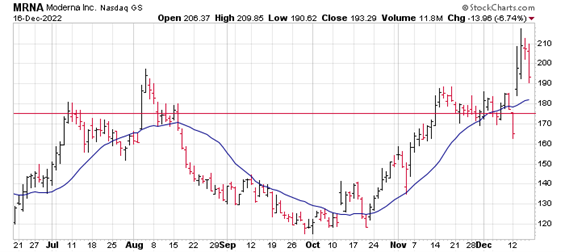
This trade is based on MRNA continuing to gain on the heels of its trial report. This is consistent with the options market, where out-of-the-money (OTM) calls are more expensive than equally OTM puts. Note also that the 20-day (blue line) sits above the strike of our spread’s short put at $175 (red line). If you agree that MRNA will continue its rally – or at least remain atop the 20-day – consider the following trade that relies on the stock staying above $175 through expiration in five weeks:
Buy to Open the MRNA 20 Jan 170 put (MRNA230120P170)
Sell to Open the MRNA 20 Jan 175 put (MRNA230120P175) for a credit of $1.35 (selling a vertical)
This credit is $0.02 less than the mid-point price of the spread at Friday’s $193.29 close. Unless MRNA surges quickly, you should be able to get close to that price.
The commission on this trade should be no more than $1.30 per spread. Each spread would then yield $133.70. This trade reduces your buying power by $500, making your net investment $366.30 per spread ($500 – $133.70). If MRNA closes above $175 on Jan. 20, both options will expire worthless and your return on the spread would be 37% ($133.70/$366.30).
Making 36%
Making 36% – A Duffer's Guide to Breaking Par in the Market Every Year in Good Years and Bad
This book may not improve your golf game, but it might change your financial situation so that you will have more time for the greens and fairways (and sometimes the woods).
Learn why Dr. Allen believes that the 10K Strategy is less risky than owning stocks or mutual funds, and why it is especially appropriate for your IRA.
Success Stories
I have been trading the equity markets with many different strategies for over 40 years. Terry Allen's strategies have been the most consistent money makers for me. I used them during the 2008 melt-down, to earn over 50% annualized return, while all my neighbors were crying about their losses.
~ John Collins
Market Like Mongo

December 12, 2022
Market Like Mongo
Database platform provider MongoDB (MDB) reported earnings after the close on Tuesday that topped estimates on all accounts. Adjusted earnings were up sharply from a year earlier, and easily topped the analyst estimate. Revenue was up nearly 50% from a year ago and beat expectations by nearly 10%. And for good measure, the company raised guidance for Q4 and fiscal 2023, with both metrics beating the consensus analyst forecast.
Despite hitting the trifecta on beating estimates, analysts were mixed in their response. The stock received one upgrade, but target price changes were both up and down. But that’s been the pattern with most stocks, as analysts are finally lowering their ridiculously high targets after stocks have slumped this year. Even so, MDB’s average target price is $273, 42% above Friday’s close. Analysts have some work to do before the target price can be taken seriously.

On the chart, MDB dropped 76% from its December 2021 high before rallying 42% in just the past month. Most of the strength came after earnings, when the stock soared as much as 29% the day after earnings. That was MDB’s largest post-earnings maximum move in its brief five-year history. The price spike also pulled the stock above its now-rising 20-day moving average and flattening 50-day moving average.
This trade is based on MDB continuing its rally on the heels of a strong earnings report, or at least staying above the 50-day moving average (blue line). Note that the short put strike of our spread (red line) is below the 50-day. If you agree that MDB will remain atop the 50-day, consider the following trade that relies on the stock staying above $170 through expiration in six weeks:
Buy to Open the MDB 20 Jan 165 put (MDB230120P165)
Sell to Open the MDB 20 Jan 170 put (MDB230120P170) for a credit of $1.40 (selling a vertical)
This credit is $0.05 less than the mid-point price of the spread at Friday’s $191.75 close. Unless MDB surges quickly, you should be able to get close to that price.
The commission on this trade should be no more than $1.30 per spread. Each spread would then yield $138.70. This trade reduces your buying power by $500, making your net investment $361.30 per spread ($500 – $138.70). If MDB closes above $170 on Jan. 20, both options will expire worthless and your return on the spread would be 38% ($138.70/$361.30).
Making 36%
Making 36% – A Duffer's Guide to Breaking Par in the Market Every Year in Good Years and Bad
This book may not improve your golf game, but it might change your financial situation so that you will have more time for the greens and fairways (and sometimes the woods).
Learn why Dr. Allen believes that the 10K Strategy is less risky than owning stocks or mutual funds, and why it is especially appropriate for your IRA.
Success Stories
I have been trading the equity markets with many different strategies for over 40 years. Terry Allen's strategies have been the most consistent money makers for me. I used them during the 2008 melt-down, to earn over 50% annualized return, while all my neighbors were crying about their losses.
~ John Collins
ULTA is More than Skin Deep

December 5, 2022
Ulta Beauty (ULTA) reported impressive earnings on Thursday after the bell that beat estimates on all counts. Earnings came in more than a dollar higher than expectations, while revenue beat by more than 4%. Same-store sales came in a whopping 60% above the analyst number. Moreover, ULTA raised full-year guidance for both earnings and sales. Significantly, the common complaints of supply chain constraints and slower consumer spending were absent from ULTA’s report and follow-up call.
Analysts cheered the news, hitting the stock with several target price increases, though there were no rating upgrades. Even so, the consensus price target is just a mere 4% above ULTA’s Friday close, while more than half the covering analysts rate the stock a hold. This suggests that future upgrades and target increases are possible, which could give the stock a boost.
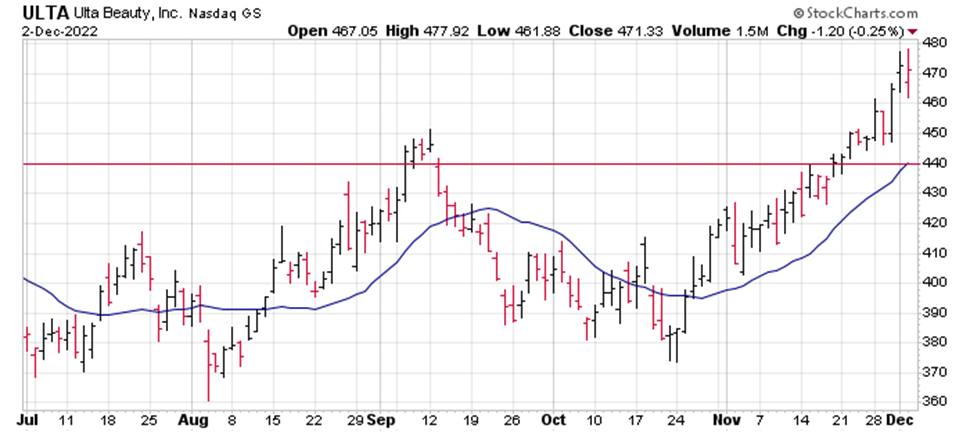
Despite the solid report, ULTA was flat on Friday. Perhaps this is because the stock is on an impressive 26% rally since late October. In fact, ULTA hit an all-time high on Friday. This rally has been tracked by the 20-day moving average, although the trendline has not been tested for the past month. We are going with a safer trade this week, going further out of the money than usual with the short strike that is sitting right on the 20-day, as shown in the chart.
This trade is based on ULTA continuing its rally on the heels of a strong earnings report. That said, we are giving the stock about 7% of downside room before the spread moves into the money. If you agree that ULTA will continue its rally – or at least remain atop the 20-day (blue line) – consider the following trade that relies on the stock staying above $440 (red line) through expiration in seven weeks:
Buy to Open the ULTA 20 Jan 435 put (ULTA230120P435)
Sell to Open the ULTA 20 Jan 440 put (ULTA230120P440) for a credit of $1.00 (selling a vertical)
This credit is $0.05 less than the mid-point price of the spread at Friday’s $471.33 close. Unless ULTA surges quickly, you should be able to get close to that price.
The commission on this trade should be no more than $1.30 per spread. Each spread would then yield $98.70. This trade reduces your buying power by $500, making your net investment $401.30 per spread ($500 – $98.70). If ULTA closes above $440 on Jan. 20, both options will expire worthless and your return on the spread would be 25% ($98.70/$401.30).
Making 36%
Making 36% – A Duffer's Guide to Breaking Par in the Market Every Year in Good Years and Bad
This book may not improve your golf game, but it might change your financial situation so that you will have more time for the greens and fairways (and sometimes the woods).
Learn why Dr. Allen believes that the 10K Strategy is less risky than owning stocks or mutual funds, and why it is especially appropriate for your IRA.
Success Stories
I have been trading the equity markets with many different strategies for over 40 years. Terry Allen's strategies have been the most consistent money makers for me. I used them during the 2008 melt-down, to earn over 50% annualized return, while all my neighbors were crying about their losses.
~ John Collins
Down Goes Tyson

November 21, 2022
Down Goes Tyson
Tyson Foods (TSN) can’t seem to get out of its own way. The company reported earnings on Nov. 14 that missed estimates on profits but beat on revenue. Higher chicken prices squeezed gross margins, which were cut in half.
But TSN has other problems. The week before earnings, the company’s CFO was arrested for public intoxication and criminal trespass. This week, the company recalled 94,000 pounds of ground beef that reportedly contained a “reflective, mirror-like material,” whatever that means.
Analysts didn’t seem to like the earnings news, as the stock was hit with a few target price downgrades. Even so, the average price target is 24% above Friday’s close, which seems overly optimistic. Perhaps the options market is more in touch with TSN’s prospects, as out-of-the-money puts are priced higher than the corresponding calls.
The stock traded lower after earnings and throughout the week, falling nearly 3%. While hardly catastrophic, the more bearish development is the continued resistance provided by the 50-day moving average. The stock hasn’t closed a day above the 50-day since it crossed below it in early August. Moreover, recent rally attempts in the past couple of weeks were firmly rebuffed.
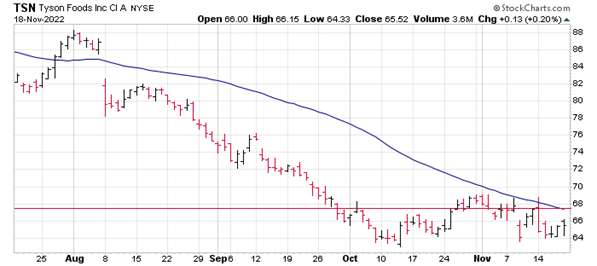
This trade is based on TSN continuing to trade sideways or lower beneath the weight of the 50-day moving average (blue line). Note that the short call strike (red line) of our credit spread lies just above this trendline, meaning that TSN will have to overcome this resistance to put our spread in danger
If you agree that TSN will continue to trade beneath the 50-day moving average, consider the following trade that relies on the stock staying below $67.50 through expiration in four weeks:
Buy to Open the TSN 16 Dec 70 call (TSN221216C70)
Sell to Open the TSN 16 Dec 67.5 call (TSN221216C67.5) for a credit of $0.50 (selling a vertical)
This credit is $0.02 less than the mid-point price of the spread at Friday’s $65.52 close. Unless TSN falls quickly, you should be able to get close to that price.
The commission on this trade should be no more than $1.30 per spread. Each spread would then yield $48.70. This trade reduces your buying power by $250, making your net investment $201.30 per spread ($250 – $48.70). If TSN closes below $67.50 on Dec. 16, both options will expire worthless and your return on the spread would be 24% ($48.70/$201.30).
Making 36%
Making 36% – A Duffer's Guide to Breaking Par in the Market Every Year in Good Years and Bad
This book may not improve your golf game, but it might change your financial situation so that you will have more time for the greens and fairways (and sometimes the woods).
Learn why Dr. Allen believes that the 10K Strategy is less risky than owning stocks or mutual funds, and why it is especially appropriate for your IRA.
Success Stories
I have been trading the equity markets with many different strategies for over 40 years. Terry Allen's strategies have been the most consistent money makers for me. I used them during the 2008 melt-down, to earn over 50% annualized return, while all my neighbors were crying about their losses.
~ John Collins
Go With VLO

October 31, 2022
Go With VLO
Oil refiner Valero Energy (VLO) reported earnings this week that either missed or beat both profit and revenue estimates, depending on the source. I won’t quibble with who’s right or wrong. What’s important is that revenue and profits soared above the figures from a year ago. Moreover, VLO’s CEO said that product demand surpassed 2019 levels.
The report was met with target price increases from several analysts. What’s interesting about VLO compared to most stocks, though, is that the average target price is only 9% above Friday’s closing price. In other words, it’s reasonable. To me, that adds some weight to the price increases we saw this week.
On the charts, the stock is down a bit since earnings. But the month-long uptrend remains intact, assisted by the 20-day moving average. The shares have not closed a day below this trendline in October, a period that includes a pullback that tested support. Based on this support, we’re going with a put credit spread with the short put strike sitting right on the 20-day (blue line) and will soon be below it. Thus, the stock will have to break through the trendline to move the spread into the money.
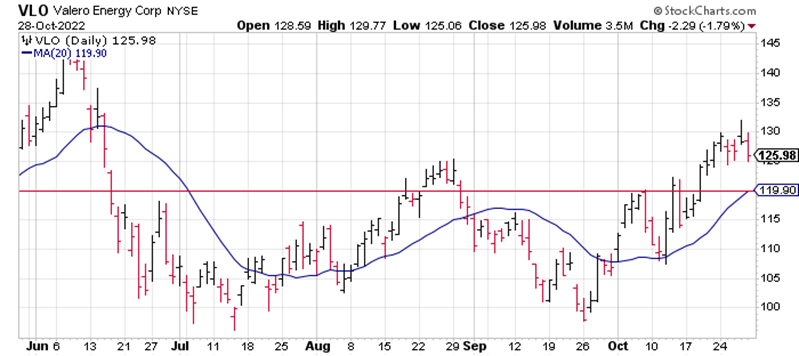
If you agree that VLO will continue to respect the 20-day, consider the following trade that relies on the stock staying above $120 (red line) through expiration in seven weeks:
Buy to Open the VLO 16 Dec 115 put (VLO221216P115)
Sell to Open the VLO 16 Dec 120 put (VLO221216P120) for a credit of $1.65 (selling a vertical)
This credit is $0.02 less than the mid-point price of the spread at Friday’s $125.98 close. Unless VLO surges quickly, you should be able to get close to that price.
The commission on this trade should be no more than $1.30 per spread. Each spread would then yield $163.70. This trade reduces your buying power by $500, making your net investment $336.30 per spread ($500 – $163.70). If VLO closes above $120 on Dec. 16, both options will expire worthless and your return on the spread would be 49% ($163.70/$336.30).
Making 36%
Making 36% – A Duffer's Guide to Breaking Par in the Market Every Year in Good Years and Bad
This book may not improve your golf game, but it might change your financial situation so that you will have more time for the greens and fairways (and sometimes the woods).
Learn why Dr. Allen believes that the 10K Strategy is less risky than owning stocks or mutual funds, and why it is especially appropriate for your IRA.
Success Stories
I have been trading the equity markets with many different strategies for over 40 years. Terry Allen's strategies have been the most consistent money makers for me. I used them during the 2008 melt-down, to earn over 50% annualized return, while all my neighbors were crying about their losses.
~ John Collins
Schwab Tested

October 24, 2022
Schwab (SCHW) reported earnings on Monday before the open that set records for both earnings per share and revenue. Both numbers exceeded the consensus analyst estimates. SCHW attributed the great quarter to its “diversified financial model and a significant benefit from higher rates.”
Analysts didn’t appear moved by the record numbers, though. There were no upgrades (nor downgrades), and just one price target decrease. Perhaps that’s because analysts have been overly bullish on a stock that is down 16% this year. Plus, analysts have an average price target that is 19% above Friday’s close.
Despite the earnings success, the stock didn’t do much in a week where the S&P 500 climbed nearly 5%. The stock couldn’t even manage a weekly gain of 2%, keeping it mired in a trading range that has persisted since late July. On the chart, the shares are looking up at the 20-day, 50-day and 200-day moving averages, all of which are pointing lower.
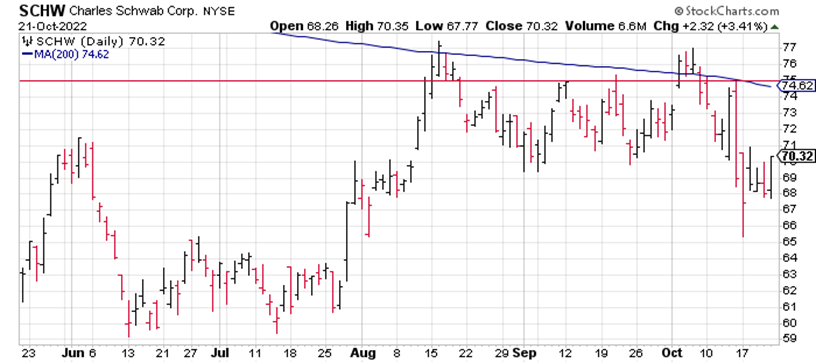
This trade is based on SCHW continuing to struggle in gaining any momentum now that earnings is past. Heavy overhead resistance should keep the stock contained. That’s why we’re going with a call credit spread with the short call strike sitting just above the 200-day moving average (blue line). Note that the 20-day and 50-day trendlines sit between the stock price and short strike, too.If you agree that SCHW will continue to trade sideways, consider the following trade that relies on the stock staying below $75 (red line) through expiration in five weeks:
Buy to Open the SCHW 25 Nov 77 call (SCHW221125C77)
Sell to Open the SCHW 25 Nov 75 call (SCHW221125C75) for a credit of $0.50 (selling a vertical)
This credit is $0.03 less than the mid-point price of the spread at Friday’s $70.32 close. Unless SCHW sags quickly, you should be able to get close to that price.
The commission on this trade should be no more than $1.30 per spread. Each spread would then yield $48.70. This trade reduces your buying power by $200, making your net investment $151.30 per spread ($200 – $48.70). If SCHW closes below $75 on Nov. 25, both options will expire worthless and your return on the spread would be 32% ($48.70/$151.30).
Making 36%
Making 36% – A Duffer's Guide to Breaking Par in the Market Every Year in Good Years and Bad
This book may not improve your golf game, but it might change your financial situation so that you will have more time for the greens and fairways (and sometimes the woods).
Learn why Dr. Allen believes that the 10K Strategy is less risky than owning stocks or mutual funds, and why it is especially appropriate for your IRA.
Success Stories
I have been trading the equity markets with many different strategies for over 40 years. Terry Allen's strategies have been the most consistent money makers for me. I used them during the 2008 melt-down, to earn over 50% annualized return, while all my neighbors were crying about their losses.
~ John Collins
On The Rocks

October 18, 2022
BlackRock (BLK) is the world’s largest asset manager with more than $10 trillion in assets under management (AUM) heading into 2022. But that has changed dramatically, as evidenced by Thursday’s release of BLK’s latest earnings report that showed AUM tumbling 16% in the third quarter. The Ukraine war, high inflation, rising interest rates and the strong dollar were all cited as reasons why investors were pulling money from BLK funds. The company is also receiving backlash for its support of environment, social and governance (ESG) initiatives.
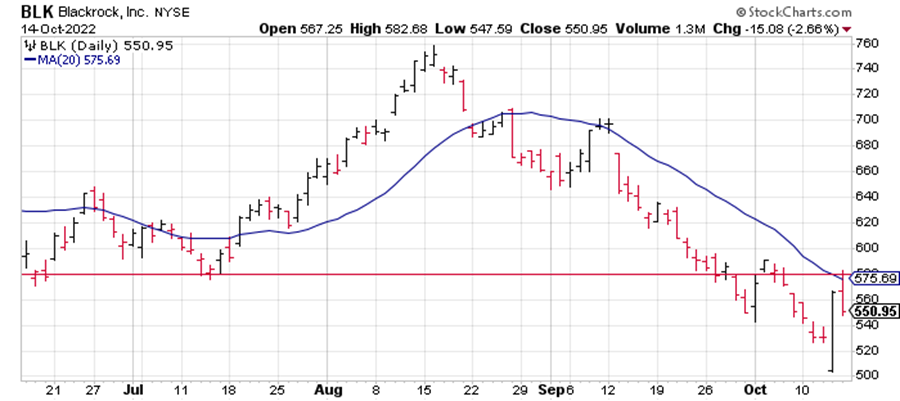
The stock gained ground the day after the report, but that was on “Bonkers Thursday” when a huge rising tide lifted all stocks. BLK retreated on Friday after encountering solid resistance at its 20-day moving average (blue line). This continues a downtrend that has been intact since mid-August. The slide has been perfectly contained by the 20-day, which hasn’t allowed a daily close above it in nearly two months. The stock is also down 40% this year, despite 75% of covering analysts rating the stock a buy.
This bearish trade is a bet that the problems plaguing BLK won’t go away any time soon. We’re going with a call credit spread with the short call sitting above the 20-day, meaning the stock will have to pierce this resistance to move the spread into the money.
If you agree that BLK will continue to decline under the weight of the 20-day, consider the following trade that relies on the stock staying below $580 (red line) through expiration in six weeks:
Buy to Open the BLK 25 Nov 590 call (BLK221125C590)
Sell to Open the BLK 25 Nov 580 call (BLK221125C580) for a credit of $3.40 (selling a vertical)
This credit is $0.10 less than the mid-point price of the spread at Friday’s $550.95 close. Unless BLK sags quickly, you should be able to get close to that price.
The commission on this trade should be no more than $1.30 per spread. Each spread would then yield $338.70. This trade reduces your buying power by $1,000, making your net investment $661.30 per spread ($1,000 – $338.70). If BLK closes below $580 on Nov. 25, both options will expire worthless and your return on the spread would be 51% ($338.70/$661.30).
Making 36%
Making 36% – A Duffer's Guide to Breaking Par in the Market Every Year in Good Years and Bad
This book may not improve your golf game, but it might change your financial situation so that you will have more time for the greens and fairways (and sometimes the woods).
Learn why Dr. Allen believes that the 10K Strategy is less risky than owning stocks or mutual funds, and why it is especially appropriate for your IRA.
Success Stories
I have been trading the equity markets with many different strategies for over 40 years. Terry Allen's strategies have been the most consistent money makers for me. I used them during the 2008 melt-down, to earn over 50% annualized return, while all my neighbors were crying about their losses.
~ John Collins
Underspiced

Spice maker McCormick (MKC) reported earnings this week that had no sizzle. Revenue and earnings both missed expectations by more than a little. The CEO said that “supply chain challenges continued, and recovery of certain constrained materials has taken longer than expected.” I’m not sure what that specifically means, but it doesn’t sound good.
The stock reacted with a brief burst on Thursday, but eventually finished lower. This shouldn’t be a surprise, though, as the stock has been in a pronounced decline since mid-August. The downtrend has covered more than 20%, pulling MKC to its lowest level since the COVID crash in early 2020. Moreover, the descent has been perfectly contained by the 20-day moving average, which hasn’t allowed a single close above it since Aug. 23.

If you agree that MKC will continue to decline under the weight of the 20-day (blue line), consider the following trade that relies on the stock staying below $75 (red line) through expiration in six weeks:
Buy to Open the MKC 18 Nov 80 call (MKC221118C80)
Sell to Open the MKC 18 Nov 75 call (MKC221111C75) for a credit of $1.45 (selling a vertical)
This credit is $0.05 less than the mid-point price of the spread at Friday’s $73.44 close. Unless MKC sags quickly, you should be able to get close to that price.
The commission on this trade should be no more than $1.30 per spread. Each spread would then yield $143.70. This trade reduces your buying power by $500, making your net investment $356.30 per spread ($500 – $143.70). If MKC closes below $75 on Nov. 18, both options will expire worthless and your return on the spread would be 40% ($143.70/$356.30).
Making 36%
Making 36% – A Duffer's Guide to Breaking Par in the Market Every Year in Good Years and Bad
This book may not improve your golf game, but it might change your financial situation so that you will have more time for the greens and fairways (and sometimes the woods).
Learn why Dr. Allen believes that the 10K Strategy is less risky than owning stocks or mutual funds, and why it is especially appropriate for your IRA.
Success Stories
I have been trading the equity markets with many different strategies for over 40 years. Terry Allen's strategies have been the most consistent money makers for me. I used them during the 2008 melt-down, to earn over 50% annualized return, while all my neighbors were crying about their losses.
~ John Collins
Warp Speed for This Lithium Producer

September 12, 2022
Warp Speed for This Lithium Producer
Sociedad Quimica y Minera de Chile (SQM) producers highly sought after commodities, most notably lithium and potassium fertilizers. Though it missed on earnings in its August earnings report, it easily beat on sales. A couple of analysts raised their price target after the news, though the overall mood toward the stock is between a buy and a hold.
But what do analysts know? SQM is up 120% this year (not a typo) … and it pays a dividend of more than 11%. The stock has recovered what it lost following earnings and came within four cents of hitting an all-time high in Friday’s trading. Though it has traded mostly sideways for the past three months, the overall uptrend remains intact, as the stock continues to put in higher lows. Plus, its 20-day and 50-day moving averages are pointed higher.

This trade is a play on SQM’s continued strength as it sits in one of the most favorable sectors within the global economy – supplying EV battery makers. We are thus going with a put credit spread with the short put sitting below the 20-day moving average (blue line).
If you agree that SQM will continue its uptrend, consider the following trade that relies on the stock staying above $100 (red line) through expiration in six weeks:
Buy to Open the SQM 21Oct 95 put (SQM221021P95)
Sell to Open the SQM 21Oct 100 put (SQM221021P100) for a credit of $1.10 (selling a vertical)
This credit is $0.02 less than the mid-point price of the spread at Friday’s $111.12 close. Unless SQM pops quickly, you should be able to get close to that price.
The commission on this trade should be no more than $1.30 per spread. Each spread would then yield $108.70. This trade reduces your buying power by $500, making your net investment $391.30 per spread ($500 – $108.70). If SQM closes above $100 on October 21, both options will expire worthless and your return on the spread would be 28% ($108.70/$391.30).
Making 36%
Making 36% – A Duffer's Guide to Breaking Par in the Market Every Year in Good Years and Bad
This book may not improve your golf game, but it might change your financial situation so that you will have more time for the greens and fairways (and sometimes the woods).
Learn why Dr. Allen believes that the 10K Strategy is less risky than owning stocks or mutual funds, and why it is especially appropriate for your IRA.
Success Stories
I have been trading the equity markets with many different strategies for over 40 years. Terry Allen's strategies have been the most consistent money makers for me. I used them during the 2008 melt-down, to earn over 50% annualized return, while all my neighbors were crying about their losses.
~ John Collins
For Whom the Bear Tolls

August 29 2022
For Whom the Bear Tolls
This is not a great time to be a homebuilder. The housing boom is over by most accounts. Consumer confidence in the housing market dropped to its lowest point since 2011. Sales of new homes plunged to a 6-1/2-year low in July. The Fed is not letting up on its interest-rate crusade. Do I need to go on?
Toll Brothers (TOL) echoed this sentiment in its recent earnings report. Although net income rose sharply in the third quarter and beat the analyst consensus estimate, revenue came up a bit short. More importantly, the homebuilder expects to deliver about 1,000 fewer units in fiscal 2022 than previously estimated.
TOL didn’t do much after earnings this week. In fact, it hasn’t done much for the past several months. The stock has been trading sideways for five months, with the top of the range around the $50 level. The fact that the shares couldn’t gain ground when housing was hot and interest rates low does not bode well for the future. Thus, we are going with a bearish call spread with the short call at the top of this trading range.

If you agree that TOL will continue sideways at best and lower at worst, consider the following trade that relies on the stock staying below $50 (blue line) through expiration in six weeks:
Buy to Open the TOL 7Oct 52 call (TOL221007C52)
Sell to Open the TOL 7Oct 50 call (TOL221007C50) for a credit of $0.45 (selling a vertical)
This credit is $0.02 less than the mid-point price of the spread at Friday’s $46.12 close. Unless TOL falls quickly, you should be able to get close to that price.
The commission on this trade should be no more than $1.30 per spread. Each spread would then yield $43.70. This trade reduces your buying power by $200, making your net investment $156.30 per spread ($200 – $43.70). If TOL closes below $50 on October 7, both options will expire worthless and your return on the spread would be 28% ($43.70/$156.30).
Making 36%
Making 36% – A Duffer's Guide to Breaking Par in the Market Every Year in Good Years and Bad
This book may not improve your golf game, but it might change your financial situation so that you will have more time for the greens and fairways (and sometimes the woods).
Learn why Dr. Allen believes that the 10K Strategy is less risky than owning stocks or mutual funds, and why it is especially appropriate for your IRA.
Success Stories
I have been trading the equity markets with many different strategies for over 40 years. Terry Allen's strategies have been the most consistent money makers for me. I used them during the 2008 melt-down, to earn over 50% annualized return, while all my neighbors were crying about their losses.
~ John Collins

Follow Terry's Tips on Twitter
Like Terry's Tips on Facebook
Watch Terry's Tips on YouTube